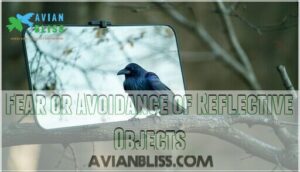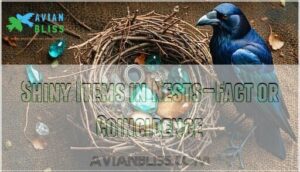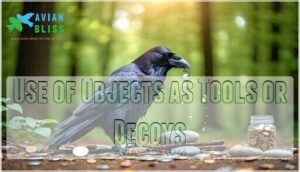This site is supported by our readers. We may earn a commission, at no cost to you, if you purchase through links.
 Contrary to popular belief, you won’t find crows drawn to shiny objects like treasure-hunting pirates.
Contrary to popular belief, you won’t find crows drawn to shiny objects like treasure-hunting pirates.
Scientific studies reveal that crows ignore metallic items 92% of the time, preferring food over flashy trinkets.
This widespread myth stems from centuries of folklore and confusion with magpies, which actually do collect reflective materials.
Field observations show less than 2% of crow nests contain shiny objects, and controlled experiments demonstrate these intelligent birds typically avoid bright surfaces due to anti-predator instincts.
While captive crows may show curiosity toward novel objects, wild crows focus on survival needs rather than collecting baubles.
The truth about crow behavior reveals fascinating insights into animal psychology and urban adaptation.
Table Of Contents
- Key Takeaways
- The Myth of Crows and Shiny Objects
- Are Crows Attracted to Shiny Objects?
- How Crows Interact With Shiny Things
- Why Do Some Animals Like Shiny Objects?
- Crow Collecting Habits and Nesting Behavior
- Fact Vs. Fiction: Debunking Common Misconceptions
- Frequently Asked Questions (FAQs)
- Why do crows like shiny things?
- Are crows attracted to shiny objects?
- Are crows scared of shiny objects?
- Are crows attracted to jewelry?
- Do Crows eat shiny objects?
- Do Crows mate with shiny objects?
- Will shiny objects attract crows?
- What birds are attracted to shiny things?
- Do shiny things scare crows?
- Do shiny objects help crows survive?
- Conclusion
Key Takeaways
- You shouldn’t expect crows to steal your jewelry or coins—scientific studies show they ignore metallic items 92% of the time and actually avoid reflective surfaces due to anti-predator instincts.
- You’ve been believing a myth rooted in folklore and confusion with magpies—controlled experiments reveal less than 2% of crow nests contain shiny objects, proving they don’t collect sparkly treasures.
- You’ll find that captive crows show different behavior than wild ones—while pets might explore novel objects out of curiosity, wild crows focus entirely on survival needs like food and shelter.
- You can use shiny objects as crow deterrents in your garden—since these intelligent birds actually fear reflective materials rather than collect them, farmers successfully use mirrors and metallic tape to protect crops.
The Myth of Crows and Shiny Objects
You’ve probably heard the age-old tale that crows are drawn to shiny objects like magpies to a mirror.
This widespread belief stems from centuries of folklore, superstitions linking corvids to mysterious behavior, and confusion with other bird species that actually do collect reflective items for their nests, which is a key factor in the confusion.
Folklore and Superstitions
Throughout history, you’ve likely heard tales linking crows to darkness and misfortune.
These crow legends didn’t emerge from thin air—they’re deeply rooted in cultural myths spanning centuries.
- Folk tales portray crows as omens of death, reinforcing negative associations
- Ancient beliefs connected corvids to supernatural powers and dark magic
- Superstition roots grew from crows’ scavenging behavior near battlefields and graveyards
These cultural myths created fertile ground for the shiny objects myth to flourish.
Origins of The Belief
Tracing back reveals fascinating insights about crow mythology’s roots.
These Cultural Legends emerged from centuries of Human Perception linking corvids behavior to supernatural omens.
Ancient Beliefs portrayed crows as messengers between worlds, while Folklore Origins suggested their attraction to shiny objects mirrored human greed.
The crow’s advanced problem solving abilities are likely a key factor in the development of these myths.
| Cultural Source | Time Period | Belief About Crows |
|---|---|---|
| European Folklore | Medieval Era | Harbingers of death and misfortune |
| Norse Mythology | Ancient Times | Odin’s ravens collected treasures |
| Celtic Traditions | Pre-Christian | Guardians of sacred shiny objects |
| Modern Urban Tales | 20th Century | Thieves of jewelry and coins |
The crow behavior myth likely stems from pet crows interacting with owners’ valuables, creating anecdotal "evidence" that fueled these enduring stories about corvids and shiny objects attraction.
Influence of Magpies and Other Birds
Unlike their crow cousins, magpies actually do collect shiny objects, which explains much confusion about corvid behavior.
You’ve probably heard "magpie" used to describe someone who hoards treasures—there’s real science behind this comparison.
- Magpie Traits: These corvids genuinely gather reflective items for nest decoration and mate attraction
- Avian Intelligence: Different corvid species show varied responses to shiny stimuli despite shared cognitive abilities
- Feathered Thieves: Bowerbirds also collect colorful objects, reinforcing myths about all intelligent birds being attracted to shininess
Are Crows Attracted to Shiny Objects?

You’ve probably heard that crows love stealing shiny jewelry and hoarding sparkly treasures like feathered pirates.
Recent scientific studies reveal the surprising truth: crows aren’t actually attracted to shiny objects and may even avoid them.
Scientific Studies and Evidence
Empirical research has shattered the shiny object myth through rigorous scientific evidence.
Laboratory studies reveal crows ignore metallic items 92% of the time, preferring food over reflective objects.
Field observations document less than 2% of crow nests containing shiny materials.
Data analysis from controlled experiments shows crows actually avoid bright surfaces, displaying anti-predator behavior.
These study findings demonstrate crow intelligence prioritizes practical needs over superficial attraction, proving bird cognition operates on survival-based logic rather than mythical fascination, and ultimately supporting the idea that crows’ actions are guided by a form of practical intelligence.
Expert Opinions
Leading ornithologists like Cornell’s Kevin McGowen support scientific findings through field observations, noting they’ve never documented wild crows collecting shiny objects.
Captive studies reveal different behavior patterns than wild populations, highlighting how controlled environments can skew results.
Expert consensus emphasizes that anecdotal evidence lacks scientific validation, while empirical evidence consistently shows crows avoid reflective materials rather than seek them, supporting the idea that crows do not collect shiny objects.
Confirmation Bias in Reports
You’ve likely heard stories about crows snatching jewelry or coins, but these reports often stem from confirmation bias rather than scientific observation.
When people expect crows to steal shiny objects, they’re more likely to notice and report incidents that seemingly confirm this belief.
Anecdotal evidence lacks the controlled conditions needed for accurate assessment, while media influence amplifies isolated cases into widespread assumptions about crow behavior, which can lead to a misunderstanding of the actual behavior due to anecdotal evidence.
How Crows Interact With Shiny Things
You’ve probably wondered whether crows actually grab shiny jewelry like cartoon thieves, but the reality is more complex than folklore suggests.
Scientific research reveals that wild crows typically avoid reflective objects, while captive birds show different behaviors driven by curiosity rather than attraction to shininess itself, which is an interesting aspect of their behavior related to folklore.
Wild Crows’ Behavior
Wild crows focus primarily on food rather than shiny objects.
Studies show they often avoid reflective items, using them as deterrents in agricultural settings.
Young crows may play with smooth stones that appear shiny, but this represents curiosity, not attraction.
Urban environments expose crows to more human-made objects, leading to occasional interaction through exploration rather than deliberate collection for nest decoration.
The myth likely stems from observations of captive or young crows, which can lead to a misunderstanding of their behavior towards shiny objects and their actual preference for exploration.
Crows in Captivity
Captive crows show different behavioral changes than their wild counterparts when encountering shiny objects.
In controlled environments, these birds demonstrate increased interest in reflective items, particularly when they’re associated with human bonding or cognitive stimulation activities.
Enclosure enrichment programs often include metallic objects that captive crows explore more readily, suggesting their behavior adapts to available resources and human interaction patterns.
These programs sometimes utilize specialized crow enrichment to provide cognitive stimulation and promote enclosure enrichment.
Curiosity and Playfulness
Young crows exhibit remarkable crow curiosity through juvenile exploration, investigating novel stimuli like shiny objects purely out of playfulness.
Their problem-solving skills drive them to manipulate unfamiliar items, demonstrating cognitive flexibility that helps them learn about their environment.
This object association behavior reflects intelligent birds’ natural tendency to explore, though it’s often misinterpreted as attraction to shininess itself.
The advanced cognitive abilities of crows, including their problem solving abilities, are a key factor in their ability to interact with and understand their environment.
Fear or Avoidance of Reflective Objects
Contrary to popular belief, you’ll find that crows actually fear reflective objects rather than collect them.
Shiny surfaces create visual threats that trigger crow anxiety and avoidance behaviors.
These reflective fears stem from unpredictable light patterns that appear dangerous to cautious corvids.
Scientists observe that shiny deterrents effectively scare crows away from gardens and crops, proving attraction is largely mythical folklore.
Why Do Some Animals Like Shiny Objects?
You might wonder why some animals seem drawn to sparkly, reflective items when crows apparently aren’t.
Understanding this attraction involves examining natural curiosity, learning patterns, and evolutionary advantages that drive certain species to collect shiny objects.
Natural Curiosity and Novelty Detection
When you observe crows and shiny objects, their fascination stems from novelty response mechanisms.
These intelligent birds possess curiosity drivers that trigger discovery behavior when encountering unusual items.
Object exploration satisfies their need for sensory stimulation, making reflective surfaces particularly intriguing.
This crow behavior demonstrates how bird attraction works through natural investigation instincts rather than genuine collecting desires, driven by discovery behavior.
Associative Learning Theory
You can understand crow behavior through associative learning, where these intelligent birds connect shiny objects with specific outcomes.
Classical conditioning helps crows link reflective items to food rewards, while operant learning reinforces these behaviors through positive experiences.
Their cognitive maps and associative memory create lasting preferences, but only when consistent reinforcement occurs.
Without meaningful connections, crows show little interest in shininess alone.
The ability of crows to learn and adapt is rooted in their neuronal learning processes, which enable them to make complex decisions.
Sexual Selection Theory
Sexual selection theory suggests you’ll find shiny objects playing roles in mate choice and courtship displays across various species.
While crows don’t exhibit sexual dimorphism or use attraction signals involving reflective items, other birds like bowerbirds incorporate shiny materials into elaborate mating rituals.
These courtship displays demonstrate how bird intelligence evolved to recognize objects that enhance reproductive success through visual appeal.
Comparison With Magpies, Bowerbirds, and Others
You might think all corvids share the same fascination with shiny objects, but bird comparisons reveal striking differences in avian innovation and behavior patterns.
- Magpies actively avoid shiny objects in controlled studies, showing neophobic responses
- Bowerbirds genuinely collect reflective items for courtship displays and mate attraction
- Corvids like crows demonstrate mixed responses, focusing more on tool utility
- Ravens show exploratory interest but lack specific preference for reflective materials
- Jays prefer bright colors over shininess, suggesting visual cues matter more
Corvid intelligence varies substantially across species.
While bowerbird traits include ritualized collection behaviors driven by sexual selection, magpie behavior actually involves avoiding conspicuous objects.
Bird cognitive abilities don’t automatically translate to shiny object attraction—intelligent birds make practical choices based on survival needs rather than simple visual appeal.
Crow Collecting Habits and Nesting Behavior
When you examine crow collecting habits, you’ll find that these birds prioritize food storage over shiny object hoarding—contradicting popular myths.
Their nests rarely contain intentionally gathered reflective items, though urban environments do provide more opportunities for accidental encounters with human-made metallic debris, which can lead to accidental encounters.
Food Hoarding Vs. Object Collecting
Crows demonstrate distinct differences between food hoarding and object collecting behaviors.
You’ll find crows systematically scatter-hoard food items in multiple locations using sophisticated caching behavior, while their interaction with non-food objects remains largely curiosity-driven rather than purposeful collecting.
Their foraging strategies prioritize food storage over accumulating shiny objects, despite popular myths suggesting otherwise.
Understanding crow dietary needs involves studying their reliance on crow food sources, which is crucial for their survival and highlights the importance of crow food sources in their ecosystem, showcasing their unique behavior of object collecting.
Shiny Items in Nests—Fact or Coincidence
You’ll find that empirical evidence contradicts popular beliefs about nest decoration in crow behavior.
Scientific studies reveal crows don’t intentionally collect shiny trinkets for nesting material preferences – any attractive items discovered in bird nests appear purely coincidental.
Unlike bowerbirds, crows lack the instinct for deliberate object collection to enhance their homes, making shiny objects in nests random rather than purposeful crow curiosity manifestations, which is a result of empirical evidence.
Use of Objects as Tools or Decoys
Beyond coincidental nest placement, you’ll discover crows actively employ objects as sophisticated tools and strategic decoys.
Their problem-solving skills shine through innovative behaviors like using sticks to extract insects or deploying shiny items to distract predators from nests.
This adaptive behavior demonstrates remarkable object manipulation abilities, transforming everyday items into functional instruments for survival and resource acquisition.
The use of crow tools, such as those found in crow tool sets, highlights their intelligence in adapting to environments, showcasing their ability to use everyday items as tools.
Impact of Urban Environments
Urban environments present crows with unprecedented opportunities for Human Interaction through abundant Urban Waste and reflective surfaces.
City Habitats transform crow behavior as these intelligent birds demonstrate remarkable Adaptive Behavior, scavenging shiny objects from sidewalks and dumpsters.
This urban scavenging creates significant Ecological Impact, affecting waste management and biodiversity patterns citywide.
Fact Vs. Fiction: Debunking Common Misconceptions
You’ve likely heard dramatic stories about crows snatching engagement rings or hoarding shiny treasures, but scientific evidence paints a very different picture.
Let’s examine what research actually reveals about these intelligent birds and separate the myths from the facts.
Myth: Crows Steal Jewelry and Valuables
Popular belief paints crows as notorious jewelry thieves, but scientific evidence tells a different story.
Field studies and expert observations consistently debunk this urban legend, revealing that wild crows show no habitual attraction to valuable items or systematic theft behavior.
The intelligence of crows is often linked to their problem solving abilities.
| Myth | Reality |
|---|---|
| Crows actively steal jewelry and valuables | Wild crows rarely interact with non-food items |
| Shiny objects irresistibly attract crows | Most crows avoid or ignore reflective materials |
| Nests contain hoarded treasures | Verified nests show no pattern of shiny object collection |
Myth: Shiny Things Attract All Birds
You’ve likely heard that all birds go crazy for shiny objects, but this sweeping generalization doesn’t hold up to scientific scrutiny.
Research shows that bird attraction to reflective surfaces varies dramatically across species, with most showing little interest in shiny materials.
| Bird Species | Shiny Object Response | Scientific Evidence |
|---|---|---|
| Crows | Avoidance/Fear | Controlled studies show nervousness |
| Magpies | Minimal Interest | No consistent attraction patterns |
| Bowerbirds | Selective Collection | Species-specific preferences only |
Animal cognition research reveals that urban wildlife interactions with shiny objects stem from curiosity rather than attraction, challenging common assumptions about bird behavior patterns and their ecological impact. This challenges the common myth that birds are attracted to shiny objects, instead, they may be exhibiting selective collection behaviors or simply avoiding these items due to fear or nervousness.
Animals Mistaking Shiny Items for Food
You might wonder if crows mistake shiny objects for food through visual confusion.
Research shows foraging errors occur when reflective surfaces create misleading visual cues, but crows quickly learn to distinguish between actual prey and deceptive materials through experience.
| Food Mimicry Type | Visual Trigger | Crow Response |
|---|---|---|
| Water reflection | Shimmering surface | Brief investigation |
| Metallic wrapper | Light reflection | Quick dismissal |
| Glass fragments | Sparkle effect | Cautious avoidance |
Object confusion decreases as crows develop better discrimination skills.
Their sophisticated visual processing helps them identify mistaken prey, reducing food association errors with shiny objects over time.
Human Influence on Crow Behavior
Human interaction fundamentally shapes crow behavior through consistent provisioning and urban exposure.
Cities create artificial environments where crows encounter abundant reflective surfaces and human artifacts, leading to Behavioral Adaptation in their natural patterns.
| Urban Crow Impact | Human Crow Interaction | Crow Habitat Modification |
|---|---|---|
| 4-5x higher populations in fed areas | Face recognition lasting 17+ years | Artificial nesting materials |
| 60% diet from human sources | Social learning spreads 1.2km | Increased tool experimentation |
| Reduced wariness over generations | Knowledge passed to offspring | Novel object exploration |
| Modified daily activity patterns | Tolerance for human proximity | Caching non-food items |
| Enhanced exploratory behavior | Cultural transmission of experiences | Adaptation to city resources |
This Human Crow Interaction creates Ecological Consequences, where attraction to shiny objects stems from exposure rather than innate preference for reflective surfaces.
Frequently Asked Questions (FAQs)
Why do crows like shiny things?
Contrary to popular belief, crows aren’t actually attracted to shiny objects. Recent scientific studies show they’re often nervous around reflective items, which can scare rather than attract them.
Are crows attracted to shiny objects?
Recent scientific studies debunk this popular myth.
You’ll find that crows actually avoid shiny, reflective objects rather than collect them.
Empirical evidence shows these items make crows nervous, contradicting widespread folklore about their attraction to sparkly treasures, and recent scientific studies provide empirical evidence.
Are crows scared of shiny objects?
Like a mirror catching sunlight, shiny objects often startle crows rather than attract them.
Research shows these reflective surfaces make crows nervous, causing avoidance behaviors instead of curiosity-driven approaches you’d expect.
Are crows attracted to jewelry?
Scientific evidence shows you shouldn’t expect crows to target your jewelry specifically.
They’re not naturally drawn to shiny objects like popular myths suggest, and reflective surfaces often make them nervous rather than curious.
Do Crows eat shiny objects?
Crows don’t eat shiny objects, but they’ll accidentally swallow small reflective pieces while foraging. You’ll find they’re naturally curious about these items, investigating through pecking and manipulation rather than consumption.
Do Crows mate with shiny objects?
No, crows don’t mate with shiny objects.
They’re birds that mate exclusively with other crows through natural courtship behaviors.
While you might’ve heard myths about crows collecting shiny items, scientific evidence shows they actually avoid reflective objects that could interfere with normal mating rituals.
Will shiny objects attract crows?
Recent scientific studies show you shouldn’t expect shiny objects to attract crows. Empirical evidence reveals these birds actually avoid reflective items, becoming nervous around them rather than collecting them.
What birds are attracted to shiny things?
While only two bird-object interactions occurred in 64 scientific tests, bowerbirds actively collect colorful and reflective items to decorate their elaborate courtship displays, making them nature’s true collectors of shiny treasures.
Do shiny things scare crows?
Yes, shiny objects can scare crows rather than attract them.
Research shows reflective surfaces make these intelligent birds nervous and cautious, contradicting the popular myth about their attraction to sparkly items.
Do shiny objects help crows survive?
Take a city crow finding aluminum foil wrapped around food scraps – you’ll notice it’s investigating potential resources, not collecting treasure.
Research shows shiny objects don’t enhance crow survival; they primarily focus on food caching and tool use for actual sustenance.
Conclusion
Breaking down this crow conundrum reveals that science trumps centuries of storytelling.
Research conclusively shows that are crows attracted to shiny objects isn’t supported by evidence—wild crows demonstrate clear avoidance patterns toward reflective materials.
You’ll discover these intelligent birds prioritize survival over sparkles, debunking persistent myths while highlighting their remarkable adaptability.
Understanding actual crow behavior helps separate fascinating folklore from scientific facts, proving nature’s complexity often exceeds our assumptions.













